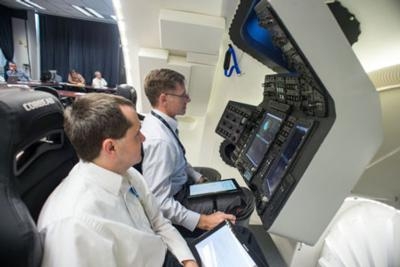Sat, Mar 01, 2014
Simulated Mission Satisfies A NASA Testing Requirement
Chris Ferguson, Boeing's director of Crew and Mission Operations and commander of the final Space Shuttle flight, virtually returned to space recently in the Boeing Crew Space Transportation (CST)-100 simulator to satisfy a NASA testing requirement for the spacecraft.

Ferguson performed manual piloting activities including on-orbit attitude and translation maneuvers, docking and backing away from a virtual International Space Station and a manual re-entry to Earth in the simulator. "It was great to be back in the pilot’s seat, even if I didn't leave the ground," Ferguson said. "It's important for the spacecraft to have manual controls because although it's designed to be largely autonomous, the pilot should always be able to back up that autonomy. Manual flight controls provide a sort of a belt-and-suspenders capability for piloting the spacecraft."
The testing for NASA officials satisfied a CST-100 development milestone known as "Pilot in the Loop." It is the final milestone before the spacecraft's critical design review.
Ferguson, a veteran of three shuttle missions and commander of STS-135, the final shuttle flight, has logged more than 40 days in space and 5,700 hours in high-performance aircraft. He now oversees the crew interface of the Boeing CST-100 spacecraft and plays a key role in development and testing of system concepts and technologies for the vehicle and integrated launch and ground systems.
"This was the one opportunity to really show off, from a user's perspective, just how real our vehicle is becoming," said Ferguson. "We demonstrated that the CST-100 is on track to return Americans to space in an American spacecraft."
The simulator will be used for preliminary astronaut training while Boeing builds additional units dedicated exclusively to training astronauts and mission controllers.
(Image provided by Boeing. Pictured: Ferguson (center) and Boeing Commercial Crew Design Team lead Steve Everett)
More News
Klyde Wonders If The 'New' SouthWest Can 'Out-Spirit' Spirit... FMI: www.klydemorris.com>[...]
From 2012 (YouTube Edition): Extensive Expertise in Backup Solutions Makes MCIA Uniquely Qualified In This Market There's no such thing, in aviation, as TOO much caution... hence t>[...]
Aero Linx: Historic Aircraft Association (HAA) The Historic Aircraft Association (HAA) was founded in 1979 with the aim of furthering the safe flying of historic aircraft in the UK>[...]
Jamming Denotes emissions that do not mimic Global Navigation Satellite System (GNSS) signals (e.g., GPS and WAAS), but rather interfere with the civil receiver's ability to acquir>[...]
"Respectfully, U.S. and European airlines should not be even contemplating the future purchase of airplanes from Chinese military companies...” Source: US Representative Raja>[...]
 Klyde Morris (05.02.25)
Klyde Morris (05.02.25) Classic Aero-TV: Introducing The MD302--Mid-Continent's Standby Attitude Module
Classic Aero-TV: Introducing The MD302--Mid-Continent's Standby Attitude Module ANN's Daily Aero-Linx (05.04.25)
ANN's Daily Aero-Linx (05.04.25) ANN's Daily Aero-Term (05.04.25): Jamming
ANN's Daily Aero-Term (05.04.25): Jamming Aero-News: Quote of the Day (05.04.25)
Aero-News: Quote of the Day (05.04.25)



